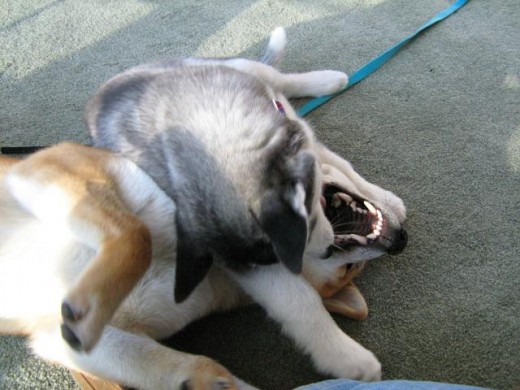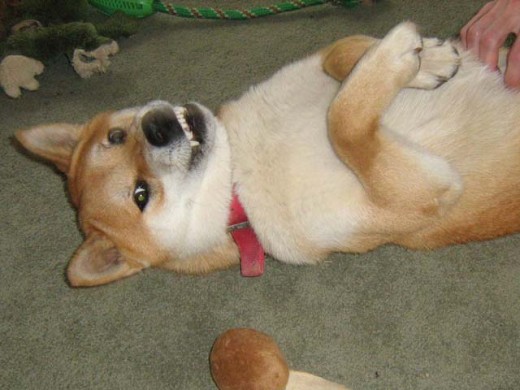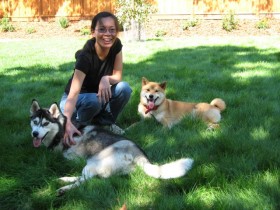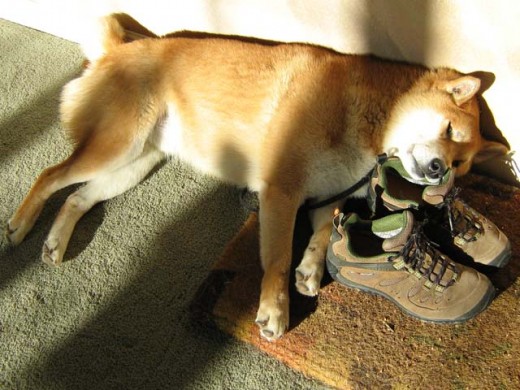Why do puppies bite?
Unlike us, puppies do not have opposable thumbs, so they manipulate stuff with their mouths, in the same way that we manipulate stuff with our hands. New puppies or young dogs will try to put everything into their mouths, because they are curious about objects and their surroundings.
Therefore, puppy biting is normal canine behavior.
Puppies also play with each other through play-biting. When a puppy bites too hard during play, his siblings may yelp and stop interacting for a short duration. Biting too hard on an adult dog (e.g. their mother), may also result in an undesirable consequence. In this way, puppies learn social rules and boundaries.

There is nothing wrong with dogs or puppies biting each other during play, but it is crucial to teach them to be careful with their mouths when interacting with people.
A puppy who is not taught this lesson, may become a danger to all the people around him, including his owners. Play-biting with humans, especially seniors and children, may cause accidental injuries and ultimately result in forced euthanasia.
If our puppy is biting us or others in an uncontrolled way, it is best for everyone not to engage in rough play with him. Also, do not play games that encourage biting such as Tug-of-War.

How to Deal with Puppy Biting
I deal with puppy biting by training my dog in three important areas –
1. Bite inhibition training
People have thinner and more sensitive skins than dogs do. Therefore, one of the first things that I teach my puppy is to control the force of his bites, especially when interacting with me and others.
2. Redirection and no-bite conditioning
When my dog bites on people, clothing, or unsanctioned objects (e.g. books, wires), I no-mark to let him know that it is an undesirable behavior. Then, I redirect his mouth onto something acceptable, and reward him for doing the right thing. In this way, he learns which objects are off-limits, as well as what he should do instead.
3. Excitement and self-control
An over-excited puppy, who lacks self-control, will tend to bite more often and with greater force. By managing my puppy’s excitement level and teaching him to control his impulses, I set him up for success, and reduce the number of instances where he engages in bad biting behavior.
An ounce of prevention is worth a pound of cure.
~~[Benjamin Franklin]
When dealing with puppy biting issues, I always try to stay calm but firm. I do my best to catch problems early on, and fix them before they escalate in degree and frequency.
If a dog is causing puncture wounds, or escalating his aggressive biting behavior, it is best to get professional help as soon as possible.
In this article, I discuss bite inhibition training and no-bite conditioning. For more on managing a puppy’s excitement level, please refer to Managing Puppy Excitement and Self-Control.
Bite Inhibition


Some dogs may have low bite thresholds. This means that they resort to biting or aggression even with fairly low, seemingly harmless stimuli.
One of my dogs, a Shiba Inu, can get mouthy when he is excited or frustrated, when I restrain him, when I stop him from doing something, and much more. Because of this, it is extremely important to train him to have good bite inhibition.
I start bite inhibition exercises as soon as I bring a puppy home. Even though puppy teeth are sharp, a puppy does not have the jaw strength of an adult, and is not capable of doing as much damage. Once my puppy has a soft mouth, I train him to stop biting on people.
Hand-feeding is a good way to teach our puppies to control the force of their bites. I hand-feed my puppy at least some of his kibble every day. If he bites too hard when getting his food, I do a sharp ouch or yelp, and ignore him for a few seconds. This teaches him that if he bites too hard, the food stops.
If my puppy is taking food from me gently, I praise him and keep the food coming. Often, I will combine hand-feeding with puppy obedience training and dog grooming sessions. Hand-feeding can also help prevent food aggression issues, so I continue this practice throughout my dog’s life.
We can also get Ian Dunbar’s book After You Get Your Puppy, for an overview of bite inhibition training.
Initially, Dunbar may come across as somewhat alarmist. We may feel that if we do not meet his somewhat unrealistic dog socialization and puppy training demands, things are going to go badly. I just try to ignore the alarmist talk, and focus on the bite inhibition and handling exercises, which are quite useful.
I am very thankful that my puppy (now adult dog) has a soft mouth. Because my Shiba Inu has good bite inhibition, we were able to solve many of his subsequent issues, which would have been difficult to deal with if he were biting at full strength.

When Our Puppy Bites …
When our puppy bites, it is important NOT to jerk our hand away. If we jerk away, we will likely get scratched. In addition, sudden and quick movements may make our puppy think that it is a fun game. This rewards the biting behavior, and encourages him to bite on us even more.
In the worst case, quick movements can activate a dog’s prey drive, and encourage aggressive behaviors. Therefore, it is important to control this reflex action, and stay still. In addition, I give a no-mark or yelp as a puppy might do to his litter-mates, when they are playing too rough.
I usually yelp when it is an accidental dog bite, for example when my dog gets his teeth on me while taking food out of my hand. Yelping is also appropriate for puppies that are still learning the rules. Otherwise, I use No for adult and adolescent dogs, who should know better.
After the no-mark, I always follow-up with a positive command, e.g. redirect him onto a toy.

1. Redirect Our Puppy onto a Toy

This technique is especially useful for an untrained puppy. It lets him know that it is ok to bite on a toy, but not ok to bite on people.
For example, my dog gets excited and starts biting when I scratch his tummy. Therefore, I used that as a training exercise to get him to bite on a toy, instead of on my hand. Since I can start the exercise anytime I want, I control the environment and make sure that I have multiple soft toys nearby for use. I make sure to reward my dog very well with food and affection when he redirects, so that I further reinforce the behavior.
A toy can also be useful for those cases where the puppy is losing control, and getting a bit too excited or frustrated. Giving him something to redirect his excitement or frustration at, may help to calm him down.
If I do not have a toy handy, I can also redirect by giving my puppy an alternate and simple command that he knows very well, e.g. Sit.

2. Withdraw Attention and Affection
Often, a puppy starts to bite at us because he wants to play or interact. Therefore, if my puppy does not respond to my redirect, then I withdraw my attention and affection. I do this by standing up, folding up my arms, and ignoring him. I make sure not to give any eye contact, not to talk, and not to engage him in any other way.
This is also called a timeout lite.
By doing this, my puppy learns that-
Out of control biting and jumping = No play, no attention, and no affection,
Gentle interaction = Play continues, food rewards, and extra attention.
Sometimes, my puppy may get too excited and escalate his behavior by biting on feet, or jumping and trying to bite on clothing. This is something that I absolutely do not allow because it can be very dangerous, especially with children and the elderly.
If my puppy escalates his behavior, I no-mark, say “Timeout”, and take him to a low stimulus timeout area immediately.
NOTE – In general, I try to set my dog up for success by managing his excitement level. In this way, I keep timeout-necessary episodes to a minimum.
3. Timeout

Most dogs value their freedom to roam around the house and backyard. Dogs are also pack animals, and like being with both human and canine members of the family. Since a timeout takes away both of these things, it is an extremely effective method of dog discipline.
When giving my dog a timeout –
- I make sure to put him in a really boring room, with no windows that he can reach. Currently, my dog’s timeout area is the laundry room.
- I check that the room is safe, and contains nothing that he can chew, play, or interact with in any way.
- Finally, I ensure that nobody gives puppy any attention during his timeout period.
It is better not to use a crate for timeouts. Crates are useful for transportation, management, and more. Therefore, I ensure that the crate is a happy place, where my dog feels comfortable going to for some peace and quiet, for sleep, and to chew on his favorite toy.
I find that a timeout is the most effective way to stop my dogs from biting. However, I only use it when my puppy is deliberately acting out, and not for accidental bites.
Initially, I start with a short 1 minute timeout. If my dog continues to bite right after he comes out, I return him to the laundry room for a much longer period of time (about 15 minutes). Be flexible with the timeout duration, and adjust it according to our dog’s age, temperament, and behavior. Some trainers do not believe in long timeouts, while others may ignore their dogs (timeout lite) for hours.
Do not use timeouts for training mistakes or lack of motivation.

How to Stop Puppy Biting
Some trainers suggest using aversive techniques to stop dog biting. For example, one suggested making my hand into a fist (so my fingers are safe), and then pushing my fist gently in when my puppy bites. This is uncomfortable for the puppy, and he will likely release our hand.
While it did get my puppy to release my hand, it did not reduce his biting behavior. In fact, my dog responds badly to any aversive methods. Doing this made him want to bite on me even more, because he got a reaction, and now has something (my fist) to fight with.
The same thing occurred with spraying water on his muzzle; he just started attacking the water bottle.
Ultimately, aversive techniques were not very effective with my dog, and caused even more behavioral issues. With aversive methods, it is difficult to trick a puppy into thinking that the bad stimulus is not coming from us. This can compromise a puppy’s trust and weaken our bond with him.
Instead, when my puppy bites,
- I first use a no-mark, for example, No or Ack-Ack to let him know that it is an undesirable behavior.
- Then, I redirect him onto a toy or give him an alternate command, for example Sit. If he stops biting and follows the command, then I praise him and reward him with attention and a fun game.
- If he continues to bite, I start with a timeout-lite by first withdrawing my attention. I do this by standing up, folding my arms, and turning away from him.
- If he escalates his behavior and starts to jump or bite on my clothing, then I quickly remove him to his full timeout area.
I always try to set my dog up for success by managing his excitement level. When he starts biting, I try to redirect and turn things into a positive learning experience. I only escalate my response when I absolutely have to, and I try my best to minimize those instances.

Hello Mia,
Shibas are really stubborn and will keep doing something if they think there is even a small chance that they can get away with it.
If she bites, non-mark her (No or Ack, ack) and put her in time out. Put a drag lead on her so that you can more easily control her and take her to time-out. When she comes out, if she bites again, then put her back in time out, but for a longer period. If you keep repeating this, and are consistent, she will learn that any biting gets her put in time-out which is really not fun at all.
She could also be teething – so get her some safe chew toys to use.
Finally, you definitely want to do bite inhibition exercises with her.
http://shibashake.com/dog/bite-inhibition
Here are some other techniques that helped me with my Shiba when he was a puppy –
http://shibashake.com/dog/puppy-obedience-training
Also, try and exercise her a lot more with walks. That way she gets rid of excess energy and will be easier to train and handle while at home.
It is important not to fear your Shiba as that will cause her to misbehave more. Shibas are very sensitive to human energy, and what helped me the most was to stay calm at all times. This article on techniques I used when my Shiba was acting out may also be helpful –
http://www.shibashake.com/dog/pack-leader-to-an-aggressive-dog
Let me know how it goes.
First of all, all you advice on shibas has been so insightful and very helpful.
My Shiba Dexter (9months old) is coming along nicely. He used to nip badly but now goes and grabs a toy to show everyone when people arrive at my home or when i come home, the funniest part is that he does it of his own accord! XD
The only problem i am having with him is the small mischief he causes as soon as a back is turned. He has (on two occasions now) eaten a pumpkin shaped candle which belongs to my fiance’s parents. They are very intolerant of him seeing that he is a shiba and needs discipline while they let there dogs have free reign and never have problems (yeah right).
Anyway, i am at a loss at what to do since when i come into the room the deed is done and he is already off frolicking. any advice?
thanks
“He used to nip badly but now goes and grabs a toy to show everyone when people arrive at my home or when i come home, the funniest part is that he does it of his own accord!”
That is awesome! Shibas can be really sweet sometimes 🙂
As for the back-turning mischief, my Shiba does that too so I don’t know how much help I will be. I always keep one eye or at least one ear on him to make sure he stays out of trouble.
One thing that may help is to exercise him a lot. When my Shiba is tired, he usually just lays around and sleeps.
I also put anything most things out of his reach so when he resorts to pulling things off shelves, it is usually his own toys. In general, you don’t want to chase him around because that will only make it into a fun game and reinforce the scamp behavior. If I can’t stop him from getting it, then I just ignore my Shiba. He usually gets bored with what he has and goes off to do something else.
Another thing that I have never used myself, but could be interesting is to place pressure sensitive sound pads on areas that you don’t want him to go. However, knowing a Shiba, he may just keep testing it and grow to like the sound – lol.
Shibas love to test their boundaries – part of their roguish charm I guess. Often my Shiba will wait until I am around to cause mischief because when there is nobody around, he does not have an audience 🙂
Management of the environment is the easiest thing to do, I think.
Hi Tiger,
One thing that really worked well with my dogs is to do the following –
1. Fold you arms up.
2. Non mark her – ack-ack.
3. Turn away from her – don’t move back just turn away. Keep turning away as long as she is jumping and ignore her.
4. As soon as she stops jumping – mark that behavior – good girl. Ask her for a sit, and give her affection while she is calm.
5. If she starts jumping again, non-mark and repeat.
Playing with other dogs will help with energy a lot. If you have any dog daycares near you, they will usually have puppy classes and/or puppy play sessions. The one that I have near me organizes puppy play sessions for free. It helps with socialization and really helps get the zoomies out.
Thanks for the suggestions. We got a 7 week old black lab 2 weeks ago. She gets very excited when she sees us and jumps up and bites. We are trying hard to break the habit but some days are worse than others. I’m hoping that once she’s had her 2nd innoculation in 2 weeks and we can start walking her that it will calm her down. We’ve tried timeout which is quite successful but sadly we haven’t anywhere particularly boring for her!
Thanks for the help! I will keep you posted on how everything goes.
hello I have a 7 month old shiba who looks just like yours. He’s still mouthing on me but i’m still working on correcting that. 3 days ago my girlfriends mom gave him a steak bone to chew on in the yard. While he was working on that bone my girlfriends brother walked in front of him and all of a sudden he got up on all four, hair standing up, and started screaming and yelling at him guarding his bone. He tried to bite my girlfriends brothers foot so right away I grabbed his leash and pulled him towards me and away from my girlfriends brother. He then got a hold of my hand and started biting and chewing on it. Well he broke skin and my hand was bleeding all over the place. That was the first time i’ve ever seen him like that..any advice? He is currently enrolled in obedience class but i’m starting to think he needs one on one training since he only wants to play with other dogs while they are listening to their owners.
My Norweigan Elkhound was super-mouthy and what has worked best is a loud, sharp “ah ah, no!” or “tsch!!!” sound and then I give his body a quick poke with my finger and say “Ouch!”. Then show him where he ‘hurt’ me, so to speak. After a while, he began to show remorse and would give kisses if asked. Cute!!!
Hi John,
Re food aggression:
Here are some things to try:
1. Don’t give him any bones or other high priority items such as raw meat etc. You want to set him up for success and reduce the number of instances where he is showing aggression over food.
2. If he shows any aggressive behavior, you should non-mark him (No or Ack-ack). If he continues, remove him to timeout. Make sure you are safe at all times though, so wear thick gloves if necessary when you are taking him to time-out. This way he learns that aggression gets him nowhere and that if he is aggressive with people, he doesn’t get to be with people.
3. If he is not overly aggressive over food, you can try hand-feeding him. Only do this if he is not overly aggressive and will not just go for your hand right away. If you are able to hand-feed him, then you can start training him on bite inhibition exercises.
4. I would also start to make him work for all of his food. Use food for training, grooming, etc. Put the rest in interactive food toys so that he has to work for everything. Also follow the NILIF program – this means he has to do something for you first (e.g. Sit, Down) before he gets anything in return – including opening doors, getting a toy, getting any food, etc. This will show him that you are in control of all the resources, and the fastest way to get what he wants is to do what you want first.
5. Make sure to remove all resources when you have guests over. This will keep things safer while you are re-training him, and it will also reduce the number of aggression episodes. The less he practices it, the less it will be a habit.
Here are more food aggression techniques:
http://www.shibashake.com/dog/stop-food-aggression-stop-resource-guarding
Re classes: You are right in that private classes will be very helpful. Initially I attended both group and private classes.
The private classes I mainly used to come up with strategies for dealing with bad behaviors at home.
The group class is also useful because it helps you practice getting your Shiba’s attention in highly distracting environments. It also helps with dog-dog socialization, which is very important for a Shiba because they tend to get dog aggressive as they get older. The techniques you learn in group class will also be very helpful in the private sessions when you are trying to troubleshoot particular issues, for example food aggression issues.
In this way you can just focus on the problem behaviors during the private sessions, rather than learning how to do specific commands.
Hope this helps. Let me know how it goes.
Hi Mona,
I love the look of the Norwegian Elkhound! I have been thinking of getting one. How old is yours? When did you get him? How is his temperament? He sounds like a sweetie.
The “ack-ack” works well for my Shiba too. Finger pokes worked initially, but only for a very short time. In the long-term, redirecting onto a toy, or withdrawing my attention (time-out lite) seems to work better for my Shiba.